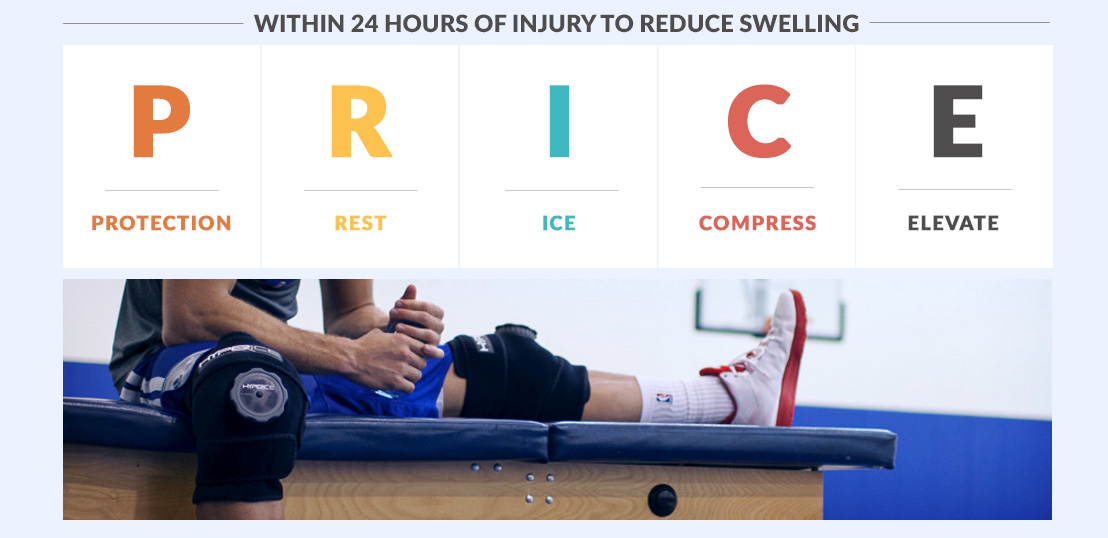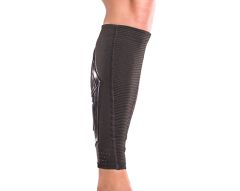PRICE the New RICE?
Ignoring minor aches and pains can only be done for so long. The “I’m fine” attitude could be further from the truth. A small, nagging pain could be the beginning of a massive injury, leaving you sidelined for months. Tackling your injuries head on can help you rather than hurt you.
Whether you’re one to ignore a small pain or not, it’s important to know that you can do simple at-home treatments to reduce severe injury: PRICE (Protection, Rest, Ice, Compress, Elevate).
Like RICE (Rest, Ice, Compress, Elevate), PRICE helps you heal quickly and protects you from reinjury. “The PRICE goal: All five steps work together to reduce the amount of time loss and speed recovery,” shares Anna Munoz, Staff Athletic Trainer/Product Education Specialist for DJO Consumer, LLC.
If you experience the slightest discomfort during or after activity, you should begin PRICE. If you see Cardinal signs of inflammation--red, heat, swelling, pain--then continue to ice, and elevate to reduce the edema or swelling.
It’s always important to seek medical attention from a professional when you experience pain. But the immediate start of PRICE at home can help speed up your recovery.
Breaking Down PRICE
Protection
Once injured you know you need to recover quickly to go about your day-to-day routine. But you also need to think about how to prevent further injury. Protection can come in any form that decreases pain and movement.
Depending on your injury will determine what the proper protection. For example, if you have a foot or ankle injury, you need to limit the amount of weight placed on your foot. Crutches take the pressure off—a form of protection. A brace, like the Aircast Stirrup, is ideal to immobilize the injury, protecting it from further pain or severity.
Best Braces for Protection
-
 $35.01On Sale 0% Off Save $0.00(33) ReviewsExperience top-tier ankle support with Aircast’s patented Aircell technology. Designed to reduce swelling and speed recovery without sacrificing comfort. Trusted by athletes and doctors alike—protect your ankle and get back in the game.
$35.01On Sale 0% Off Save $0.00(33) ReviewsExperience top-tier ankle support with Aircast’s patented Aircell technology. Designed to reduce swelling and speed recovery without sacrificing comfort. Trusted by athletes and doctors alike—protect your ankle and get back in the game.The Air-Stirrup Ankle Brace can be used to treat or prevent the following ankle injuries:
- 3rd Degree Ankle Sprain
- Acute Injuries of the Ankle
Rest
You need to allow the injury to heal, so you need to stay off the joint and eliminate all activities that cause pain. If you have an ankle injury, crutches will help take the load off of the injured area. If crutches aren’t necessary, then you may need to limit the amount of time you spend on your feet or walking.
Ice
One of the most important steps in PRICE is to ice so you can reduce inflammation and swelling. The cold causes your blood vessels to constrict, helping to decrease swelling. As soon as you notice any swelling, immediately apply ice. It’s important to do this step within the first 48 hours of the injury. The golden rule is to apply ice for 20 minutes and then take off for 20 minutes. Use a towel to ice the injury. Never apply ice directly onto the skin as this can cause burning. After several days, it’s OK to back off of icing and let your body take over.
Compress
Compress the area, but don’t cut off circulation. The goal here is to reduce swelling and pain. If you see any puffiness, apply pressure onto the injured area to reduce edema (medical term for swelling). The DonJoy Performance Trizone Calf, Ankle and Elbow are excellent compression sleeves that provide support and compression. For knee compression, consider the DonJoy Trizone Knee.
-
 $30.99On Sale 0% Off Save $0.00(26) ReviewsExperience targeted compression and support with DonJoy Performance Trizone Elbow Support. Triple-zone design reduces pain and enhances stability for tendonitis, strains, and arthritis. Perfect for athletes and active lifestyles—stay strong and pain-free every day.
$30.99On Sale 0% Off Save $0.00(26) ReviewsExperience targeted compression and support with DonJoy Performance Trizone Elbow Support. Triple-zone design reduces pain and enhances stability for tendonitis, strains, and arthritis. Perfect for athletes and active lifestyles—stay strong and pain-free every day. -
 Special Price $39.99 Regular Price $44.99On Sale 11% Off Save $5.00(29) ReviewsUnlock peak performance with the DonJoy Performance TriZone Ankle Support — your lightweight powerhouse for everyday protection. Crafted from eco-friendly, carbonized bamboo with zoned compression and silicone banding, it delivers stability, circulation, and comfort in one sleek sleeve Slip it on, stay active, and move confidently—whether you're training, competing, or recovering.
Special Price $39.99 Regular Price $44.99On Sale 11% Off Save $5.00(29) ReviewsUnlock peak performance with the DonJoy Performance TriZone Ankle Support — your lightweight powerhouse for everyday protection. Crafted from eco-friendly, carbonized bamboo with zoned compression and silicone banding, it delivers stability, circulation, and comfort in one sleek sleeve Slip it on, stay active, and move confidently—whether you're training, competing, or recovering.The Trizone Ankle Support can be used to treat or prevent the following ankle injuries:
- Strained Muscles or Tendons
- Mild Ankle Sprain
- Weak or Unstable Ankle
- Plantar Fascitis
- Swelling or Inflammation
-
 $60.04On Sale 0% Off Save $0.00(27) ReviewsThe TriZone Knee Brace combines compression and bracing in a single sleeve, featuring three targeted zones for optimal support. Crafted with carbonized bamboo for cooling and antimicrobial properties, it's designed to keep you moving through repetitive motion injuries.
$60.04On Sale 0% Off Save $0.00(27) ReviewsThe TriZone Knee Brace combines compression and bracing in a single sleeve, featuring three targeted zones for optimal support. Crafted with carbonized bamboo for cooling and antimicrobial properties, it's designed to keep you moving through repetitive motion injuries.The TriZone Knee Brace can be used to treat or prevent the following knee injuries:
- Meniscus Injury
- Tendonitis
- Muscle Strain
- Over Use Injury
- Mild Joint Instability
- Need for Compression
Elevate
You want to reduce the amount of blood flow to the injured area, which will reduce the amount of swelling. Try to elevate the injury above your heart. If you can’t do that, then at least lift the injury up so gravity isn’t pulling fluid to the hurt area. For example, if you injure your foot or ankle, sit on a chair or couch and rest the foot on a table or pillows that bring it up to heart level or as high as you can go.















